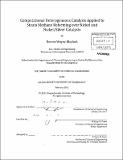| dc.contributor.advisor | William H. Green. | en_US |
| dc.contributor.author | Blaylock, Donnie Wayne | en_US |
| dc.contributor.other | Massachusetts Institute of Technology. Dept. of Chemical Engineering. | en_US |
| dc.date.accessioned | 2011-05-09T15:26:48Z | |
| dc.date.available | 2011-05-09T15:26:48Z | |
| dc.date.copyright | 2011 | en_US |
| dc.date.issued | 2011 | en_US |
| dc.identifier.uri | http://hdl.handle.net/1721.1/62730 | |
| dc.description | Thesis (Ph. D.)--Massachusetts Institute of Technology, Dept. of Chemical Engineering, 2011. | en_US |
| dc.description | Cataloged from PDF version of thesis. | en_US |
| dc.description | Includes bibliographical references (p. 182-188). | en_US |
| dc.description.abstract | The steam methane reforming (SMR) reaction is the primary industrial means for producing hydrogen gas. As such, it is a critical support process for applications including petrochemical processing and ammonia synthesis. In addition, SMR could be an important component of future energy infrastructures as a means for producing hydrogen as an energy carrier for applications including fuel cells in automobiles and direct combustion for electricity generation. Nickel is the preferred SMR catalyst; however, the efficiency of SMR over nickel can be severely hindered by carbon formation, which leads to the deactivation or even destruction of the catalyst particles. Thus, there is significant interest in catalysts that inhibit carbon formation yet retain activity to SMR. In order to develop improved catalysts for SMR, a thorough understanding of the processes occurring on the nickel surface is needed. In this thesis, computational heterogeneous catalysis is applied to investigate steam methane reforming over nickel (Ni) and silver-alloyed nickel (Ni/Ag) catalysts. Electronic structure calculations using density functional theory (DFT) are employed to develop thermochemical landscapes describing the relative stabilities of SMR intermediates on the catalyst surfaces. In addition, DFT calculations are used to obtain kinetic parameters that describe elementary surface reactions taking place during SMR. A detailed statistical thermodynamics framework is developed to allow for the calculation of enthalpies, entropies, and free energies of the surface species at the temperatures and pressures relevant to industrial SMR. The data from the DFT calculations are used to build detailed ab inito microkinetic models of SMR over the multi-faceted nickel catalyst. The resulting microkinetic models are used to provide insight into the processes occurring on the catalyst surface through identifying the most important intermediate species and reactions occurring on the catalyst. The effects of alloying the nickel catalyst with silver are predicted through modeling the dissociative methane adsorption reaction on multiple facets of the Ni/Ag surface with varying concentrations of silver. In addition, DFT calculations are used to investigate carbon formation on the Ni and Ni/Ag catalyst surfaces, including relative stabilities of various carbon-containing intermediates and the effects of alloying the nickel surface with silver on carbon formation. | en_US |
| dc.description.statementofresponsibility | by Donnie Wayne Blaylock. | en_US |
| dc.format.extent | 188 p. | en_US |
| dc.language.iso | eng | en_US |
| dc.publisher | Massachusetts Institute of Technology | en_US |
| dc.rights | M.I.T. theses are protected by
copyright. They may be viewed from this source for any purpose, but
reproduction or distribution in any format is prohibited without written
permission. See provided URL for inquiries about permission. | en_US |
| dc.rights.uri | http://dspace.mit.edu/handle/1721.1/7582 | en_US |
| dc.subject | Chemical Engineering. | en_US |
| dc.title | Computational heterogeneous catalysis applied to steam methane reforming over nickel and nickel/silver catalysts | en_US |
| dc.type | Thesis | en_US |
| dc.description.degree | Ph.D. | en_US |
| dc.contributor.department | Massachusetts Institute of Technology. Department of Chemical Engineering | |
| dc.identifier.oclc | 717289104 | en_US |
